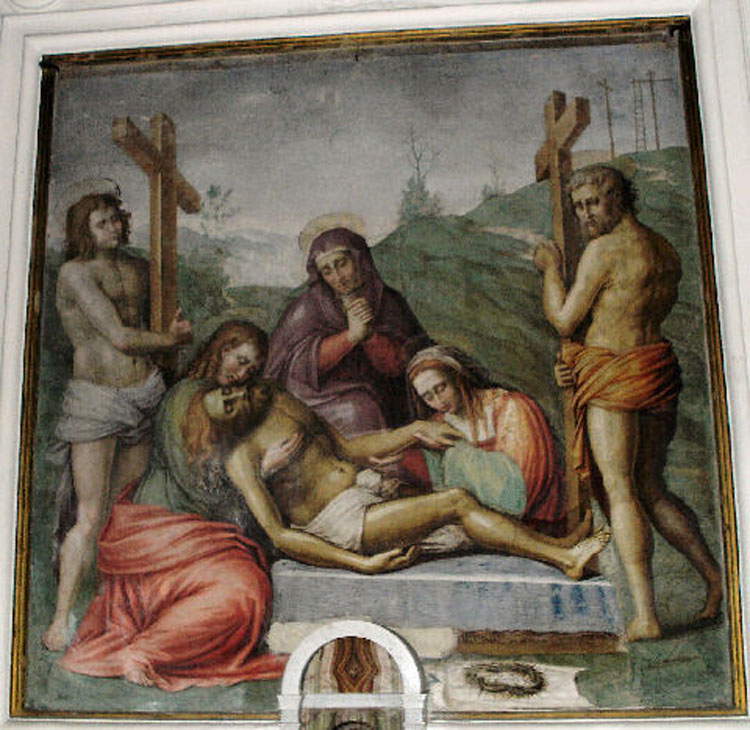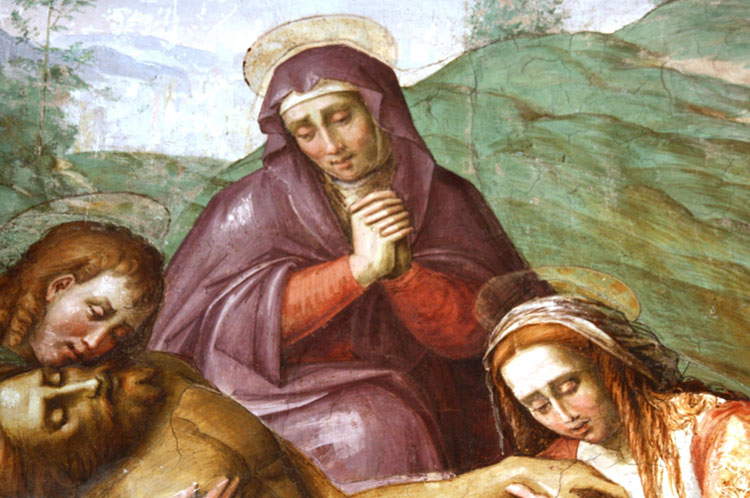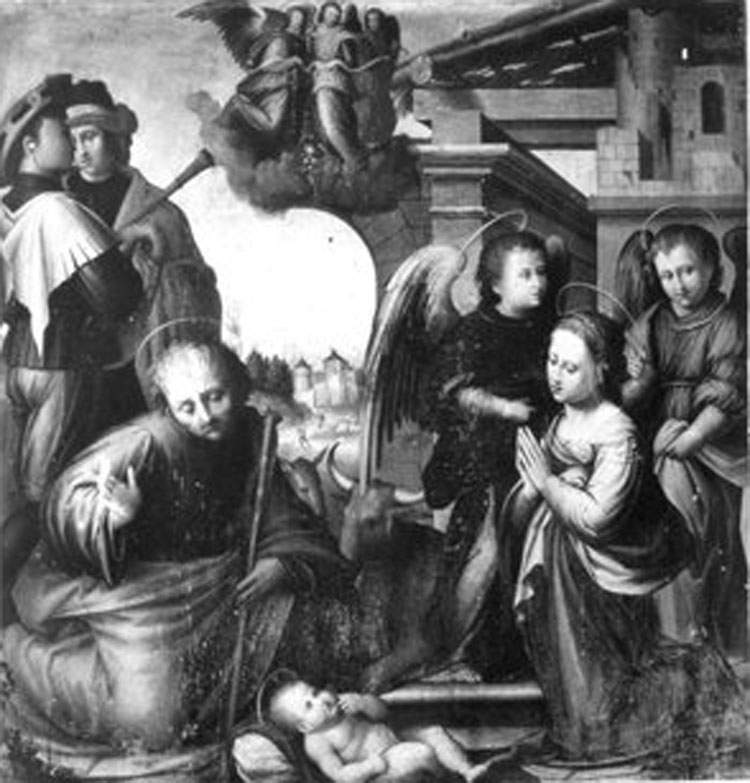A Michelangelo fresco discovered in the countryside in Florentine Chianti. The news, put in these terms (i.e., the way certain media have titled it, with a good dose of sensationalism), would be truly epoch-making: however, as happens whenever the non-specialist press gives an account of supposedly exceptional discoveries, it is always a must to investigate deeper and understand what actually lies behind the emphatic headlines. And one often ends up discovering that the media have mounted a case on nothing, reworking with certain creativity hypotheses that merge historical data (very few and in turn of dubious reliability) with flights of fancy (too many): this is exactly what happened also with the affair of the fake Michelangelo from Chianti. A work, moreover, of excellent quality and assigned by real experts (as will be seen in a moment) to an up-to-date artist, Tommaso di Stefano Lunetti (Florence, 1490 - 1564). It is not, in short, a work by Michelangelo, as far as we can tell. It is therefore a matter of going in order.
 |
| Tommaso di Stefano Lunetti, Pieta (c. 1525; fresco; Barberino di val d’Elsa, Marcialla, Parish Church of Santa Maria) |
 |
| Detail of the Pietà |
The news, summarized, goes something like this: in the church of Santa Maria in Marcialla, a hamlet in the municipality of Barberino val d’Elsa, there is a fresco that local tradition attributes to the hand of Michelangelo Buonarroti (Caprese, 1475 - Rome, 1564). A certain Robert Schoen, from the United States, presented by many newspapers (e.g., here) as “one of the top international experts” on Michelangelo, accepts the mayor’s invitation to examine the work. He therefore travels to the Chianti hills, makes an inspection and issues his own judgment: quoting a quotation mark reported byANSA, for Schoen “in that fresco is the soul of Michelangelo,” “perhaps it was painted” on the basis of “a drawing, a sketch perhaps a gift from Michelangelo to the Augustinian fathers who hosted him,” and “the painting could be by Sebastiano Mainardi.” Despite the abundance of doubts (two “maybes” and one “might” in one period), many newspapers rushed to provide the most whimsical interpretations of the so-called “expert’s” idea, coming out with headlines such as “the Marcialla Pietà is by Michelangelo,” “a Michelangelo in Marcialla,” “confirmed Michelangelo in a church in Marcialla,” and so on.
It would be enough even to read the quotation mark to understand that we are in the presence of a nonexistent case, because there are no footholds or, much less, solid bases for formulating an attribution to Michelangelo. Nor can we say that we are in the presence of a fresco created on a drawing by the great Renaissance artist, for the simple fact that the drawing does not exist, or at least, wanting to concede a remote possibility to the “supreme expert,” no source has ever mentioned it and it has never been found: that the author could have painted the Pietà on an unknown drawing by Michelangelo is nothing more than a mere supposition. And above all: we are facing an old question Indeed: very old. The Pietà of Marcialla is a work well known to Michelangelo scholars, a category in which it becomes difficult to include Robert Schoen (for reasons that will be said in a moment): and scholars have spoken out on the painting before. However, it is not well understood why the work cyclically returns to the interest of the media, and each time always with the same refrain: the hypothesis that the work may be by Michelangelo begins to come back into vogue, an “expert” intervenes who neither confirms nor denies the rumors, scientific studies are systematically ignored, a few sensational headlines come out in the press, and then everything dies down while waiting for someone, under whatever pretext (the “discovery” of a new detail, the formulation of a hypothesis that could bring the work into the picture), to bring the fresco back into fashion. This is at least the third time this has happened within ten years.
In cases such as these, the most sensible course of action is to turn to the scholarly bibliography, within which no titles by Robert Schoen appear. The American certainly cannot be counted among the “leading international experts” on Michelangelo, a role with which many media have improperly invested him: it is necessary to reduce his figure to that of a sculptor with a passion for the Florentine artist. His only contribution on Michelangelo (at least as far as I know from a quick search) is an intervention as part of the debate on the so-called Young Arch er at the Metropolitan in New York: the work, well known to scholars and whose authorship remains uncertain to this day, was seen by Schoen in 1984 in New York, at the cultural services building of the French embassy, and the sculptor intervened in the discussion by attributing the Young Archer to Michelangelo. The news, given by many today, that Schoen is “known to have identified in New York” (I quote, in this case, from the Corriere Fiorentino, but it can be found anywhere) “the Cupid sculpted by Michelangelo in 1497 of which all trace had been lost for centuries,” is without foundation. It confuses the Young Archer, a sculpture that had already been abundantly published and discussed in scholarly circles in 1984, with the Sleeping Cupid, a work attested by Michelangelo’s biographers and actually considered lost. In any case, we are very far from asserting that Schoen has unearthed works whose traces had been lost for centuries.
The scholarly bibliography has long included some contributions on the Marcialla Pietà. There is one, written by Roberto Weiss, that goes back as far as 1942 and in which he gives an account of how “a fairly ancient local tradition” attributes “the Marcialla fresco to Michelangiolo Buonarroti, but no modern scholar of Michelangiolo is aware of it.” This tradition, according to Weiss, ended up influencing eighteenth-century scholars: the art writer Anton Francesco Gori, in his notes to the Life of Michelangelo written by his first biographer, Ascanio Condivi, spoke of a “precious painting [...] which is exposed at an Altar at the right hand in the Prioral Church of Marcialla.” This painting, Gori continued, “is in fresco, and is of Michelagnolo’s first manner; and represents a Pietà, placed in the middle by the images of two Holy Martyrs.” Again, the scholar reported the tradition that “Michelagnolo did it at the juncture that he took himself to do some days of campaigning in the villa of the noble lords Serragli.” Gori’s note represents the first historical source that speaks of a stay by Michelangelo in Marcialla: but it is a source that, in turn, gives credence to village rumors (and moreover, we are almost three centuries away from the time of the events), so its reliability is already decidedly poor (not least because there are no documents that testify to a friendship between Michelangelo and the Serragli family). If anything, it is more plausible that Michelangelo had gone to Marcialla at the invitation of the prior of Santo Spirito, with whom relations are documented: the monastery of Marcialla depended on that of Santo Spirito in Florence. However, we have no record of him staying there.
Instead, to find the first document in which Michelangelo is mentioned as the author of the work, it is necessary to go back to 1689, the year in which the archbishop of Florence, Jacopo Antonio Morigia, is visiting the church of Marcialla: in the minutes it is recorded that “Contra dictum Altare Conceptionis adest in pariete picta Pietas manu pictoris Buonarroti satis pulchra,” that is, “in front of the said altar of the Conception there is, in a painted wall, a Pieta by the hand of the painter Buonarroti, rather beautiful.” Moreover, the record was already cited in an 1848 contribution (“full of errors,” Weiss called it, however) by a local scholar, Luigi Biadi: he too attributed the belief that the work was by Michelangelo to the fame surrounding the painting.
All this goes to show that the discussion of these days is something trite and that nothing new has emerged: the name of Michelangelo has been circulating for more than three centuries, and the hypotheses that the press has been spreading these days do not add anything serious to the debate, also because there are no publications on the subject yet (it is therefore also difficult to understand why Robert Schoen spoke of a probable fresco by Sebastiano Mainardi on a probable drawing by Michelangelo, since at the moment we only have his statements reported in the newspapers). At the moment, the most up-to-date (and reliable) study on the work is the one by Alessandra Tamborino published in the scientific journal Paragone in 2007: in the article, the art historian, a Renaissance specialist, speculated that the fresco was the work of Tommaso di Stefano Lunetti, for eminently stylistic reasons. In fact, it is a work that has strong affinities with the Nativity panel found in the same house of worship, and which Federico Zeri had referred to Tommaso di Stefano Lunetti on the basis of comparisons with other works by the artist, which would present quite similar characters. If there is to be seen, in this Pietà, a shadow of Michelangelo, it can be discerned in the “occurred assimilation of Michelangelo’s formal arrogance,” which in any case had “already for some years been an element made proper by many of the painters of the old and new generation.” in other words, it is well known that a great many artists working in the first decades of the 16th century (this fresco would be dated to around 1525) immersed themselves in Michelangelo’s art to draw inspiration from it and, often, to include direct quotations in their works. Since no significant new information has been published since Alessandra Tamborino’s study, it is very difficult to think (yet) that the young Michelangelo could have had any direct role in the creation of the work.
This is what we can seriously and knowledgeably say about the Marcialla painting. Everything else is nothing but background noise that debases art history and reduces it to mere matter for sensationalism.
 |
| Tommaso di Stefano Lunetti, Nativity (c. 1525; fresco; Barberino di val d’Elsa, Marcialla, Parish Church of Santa Maria) |
Warning: the translation into English of the original Italian article was created using automatic tools. We undertake to review all articles, but we do not guarantee the total absence of inaccuracies in the translation due to the program. You can find the original by clicking on the ITA button. If you find any mistake,please contact us.